Eurocopter AS-350B2
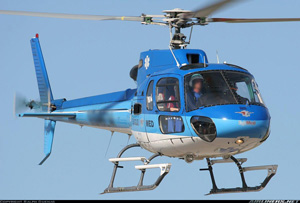
Photo copyright Ralph Duenas - used with permission
EagleMed, N918EM
Kingfisher, Oklahoma
July 22, 2010
The Eurocopter (Airbus) AS-350B2 Helicopter Air Ambulance (HAA) was dispatched under 14 CFR Part 91 on a repositioning flight to pick up a patient for transfer. One pilot, one flight nurse, and one paramedic were onboard. During this flight, the helicopter crashed into an open field after striking some trees, resulting in fatalities of the pilot and flight nurse. The paramedic was ejected from the helicopter upon impact and survived with serious injuries. The weather was reported as clear skies, ten miles visibility, winds from the south at 20 gusting to 28 knots. The post-accident investigation revealed no significant mechanical issues with the airframe, drivetrain, or engine. The paramedic reported the pilot was demonstrating a low-altitude maneuver prior to the accident. The aircraft was consumed in a post-crash fire.
The National Transportation Safety Board (NTSB) determined the probable cause of this accident to be the pilot's impaired judgment due to medications, which led to an abrupt low-level maneuver and subsequent impact with trees and terrain.
NTSB Accident Number: CEN10FA424
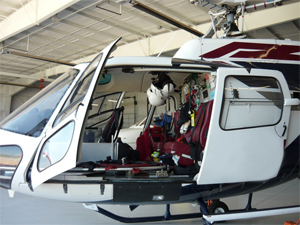
Photo copyright Paula V. Stout - used with permission
History of Flight
On July 22, 2010, at approximately 1925 local time, a Eurocopter (Airbus) AS-350B2 helicopter, N918EM, registered to and operated by EagleMed LLC, impacted terrain near Kingfisher, Oklahoma. Operating as a positioning flight under Part 91, there were three crewmembers onboard the aircraft. The commercial pilot and flight nurse were fatally injured while the paramedic sustained serious injuries. Visual Meteorological Conditions (VMC) prevailed for the flight that was operating under Visual Flight Rules (VFR). The automated weather reporting station at Wiley Post Airport (KPWA), approximately 20 nautical miles southeast of the accident site, reported weather conditions at 1953 local time as: winds from 170 degrees at 20 with peak gust of 28 knots, ten miles visibility, clear skies, temperature 90 degrees Fahrenheit (F), dew point 68 degrees F, and barometric pressure of 29.90 inches of mercury. The helicopter departed the Integris Baptist Medical Center Heliport (OK19), Oklahoma City, Oklahoma, at 1913 local time to pick up a patient in Okeene, Oklahoma. The direct course between the departure and destination was 314 degrees and the straight-line distance was approximately 50 nautical miles. The Maximum Elevation Figure (MEF) depicted on the VFR chart for this flight was 2,200 feet MSL in the grid where the accident occurred. Investigators concluded that the accident pilot was flying at least 700 feet below that altitude, at and below 400 feet AGL.
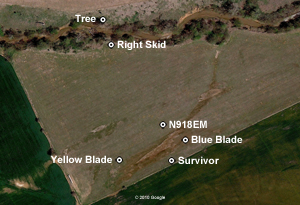
View Larger
The surviving paramedic recalled, in his statement to investigators, that during this flight the left-side door had come unlatched and was slightly ajar (about one-half inch). He advised the pilot that he was unbuckling his seatbelt and shoulder harness and coming out of his seat to close the door and latch the handle. The pilot acknowledged the notification. After closing and latching the door, the paramedic moved back to his seat. Sitting back down, but before putting his seat restraint back on, he heard conversation between the pilot and flight nurse about another pilot flying on a coyote hunt. The paramedic reported the pilot made a statement similar to "like this... (with some laughter)," followed by control inputs that resulted in aggressive maneuvers at low altitude. The helicopter struck a tree before ground impact. The paramedic, who was still not belted into his seat, was ejected through the windscreen. He managed to crawl away from the wreckage and call 911, making contact with the Kingfisher County Sheriff's Office.
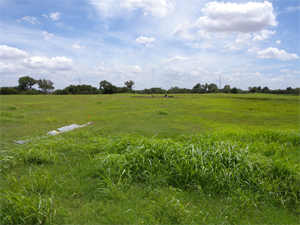
View Larger
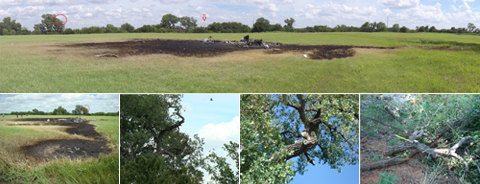
View Larger
Forensics obtained during the autopsy indicated the pilot survived the initial blunt force trauma with substantial injuries. However, he was not able to escape the fire zone and his thermal injuries were not survivable. Similarly, the flight nurse was not able to escape the fire zone and was fatally injured. The surviving paramedic was thrown clear from the post-crash fire zone but suffered significant blunt force trauma injuries.
The helicopter wreckage came to rest in a flat, grassy field at approximately 1,085 feet MSL. Tree limbs with rotor strike signatures were found in a tree line approximately 690 feet east of the main wreckage. Some helicopter debris was recovered near the tree line. The first ground scars were 115 feet east of the main wreckage and were consistent with the landing gear skids gouging the terrain. Investigators concluded the accident scene was consistent with the scenario of the helicopter impacting the ground at a shallow angle and relatively high speed.
The aircraft was equipped with a Sky Connect device, configured to make a position report every five minutes. The company monitored this flight, and the last position report was at 1919 local time. This report depicted the helicopter about 11 nautical miles southeast of the accident site at 1,509 feet MSL, approximately 300-400 feet AGL and flying northwest at 131 knots.
Additionally, a portable Garmin 496 Aviation GPS device was recovered from the scene. From the memory of the GPS unit, a download of the accident flight data was obtained from the digital memory card, revealing that prior to the accident, the helicopter was cruising at approximately 130 knots at 200-300 feet AGL. At 1924 local time, it descended at 385 fpm, then two seconds later the helicopter increased its descent rate to 1,890 fpm. The GPS location information was consistent with the accident scene.

Photo - NTSB
Eurocopter (Airbus) AS-350B2
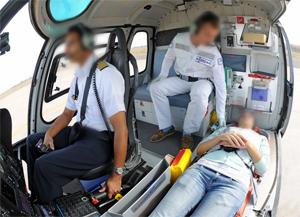
Photo copyright Airbus - used with permission
The helicopter N918EM was a Eurocopter (Airbus) AS-350B2, manufactured in 1998. It was powered by a single Turbomeca Arriel 1D1 turbo-shaft engine, which produced 732-shaft horsepower. It had accrued 3,355.6 airframe hours, and the last maintenance inspection was a 100-hour inspection on May 28, 2010, two months prior to the accident.
Accident Site
The debris path, in the direction of flight, began with portions of the helicopter's windscreen, main rotorblade components, helicopter lights, right skid, and then main wreckage to include the helicopter cockpit, cabin, transmission, and engine. An onsite examination of the helicopter's engine revealed impact evidence and foreign object damage that were consistent with power being available at the time of the accident. No pre-impact anomalies were detected with the airframe.

Photos - NTSB
View Larger
Pilot Information
The 56-year-old commercial pilot's certificate listed ratings for airplane single engine land, instrument airplane, rotorcraft-helicopter, and instrument helicopter. His current second-class medical certificate was issued on February 8, 2010. On his most recent medical certificate application, he reported having 12,241 hours accumulated flight time, with 119 of those logged in the preceding six months. On that application, he reported he was not taking any medications. A review of the company flight records indicated he had successfully completed Part 135.293 and Part 135.299 check rides on May 20, 2010. The same review of company flight records listed him as having flown 3.6 hours in April 2010, 10.1 hours in May, 14 hours in June, and 2.2 hours in July. His previous flight, on July 21, was the day before around 0300 local time.
Medical Factors
Despite the pilot's report in February 2010 stating that he was not currently taking any medications, a review of the accident pilot's medical history found that he was being treated for several medical conditions and had been prescribed multiple medications since at least 2007. These medications were for bronchitis, hypertension, and sleep apnea, and included:
- Nexium (for gastroesophageal reflux)
- Caduet (for hypertension)
- Flexeril (sedating muscle relaxant)
- Lortab (hydrocodone and acetaminophen; narcotic pain medication)
- Lunesta (for sleep disturbance)
- Requip (for restless leg syndrome)
The pilot continued to report to his personal physician that he experienced increased pain and was prescribed stronger pain medications to include prescription narcotics and benzodiazepines. In addition, steroid joint injections were applied to his right knee and shoulder to treat persistent pain. The last documented visit, February 25, 2010, the pilot was prescribed the following:
- Caduet (for hypertension)
- Omeprazole (for gastroesophageal reflux)
- Meloxicam (a non-steroidal anti-inflammatory)
- Lunesta (sleep aid)
- Norco (10/325 hydrocodone/acetaminophen combination two tablets three times a day)
- Baclofen (a muscle relaxant, 10 mg three times a day)
- Valium (diazepam, a benzodiazepine, 10 mg three times a day)
In addition to the drugs discovered during a post-mortem examination, toxicology samples detected other prohibited medications:
- Valium Hydrocodone
- Chlorpheniramine (a sedating over-the-counter antihistamine)
Investigators found no evidence that the pilot's sleep apnea had been treated prior to the accident. This disorder could be a disqualifying condition due to fatigue.
Although the pilot held a medical certificate at the time of the accident, his failure to report any of his potentially disqualifying medical conditions or prohibited medications to the FAA, the certificate holder, or to the operator invalidated his certificate.
The FAA and other non-government aviation support groups and associations offer advice and guidance on what medications are prohibited. In addition, assistance to paths for obtaining medical certification under a number of medical conditions and/or medications for special issuance circumstances are available.
Conclusion
While the pilot possessed the proper medical certificate to fly, the pilot's failure to properly report his disqualifying medical condition as well as prohibited medication invalidated his medical certificate. Investigators determined that the pilot was physically and mentally impaired due to prohibited medications and believed this led to impaired judgement and his abrupt maneuver at a low-level altitude that resulted in a crash.
The National Transportation Safety Board determined the probable cause of this accident to be the pilot's impaired judgement, due to medications, which led to an abrupt, low-level maneuver and subsequent impact with trees and terrain.
Findings:
Personnel issues
- Prescription medication - Pilot (Cause)
- Over-the-counter-medication - Pilot
- Decision making/judgment - Pilot (Cause)
- Physical - Pilot (Cause)
NTSB Accident Number: CEN10FA424
14 CFR 61.53 Prohibition on operations during medical deficiency
14 CFR 91.3 Responsibility of pilot in command
14 CFR 91.13 Careless or reckless operation
14 CFR 91.17 Alcohol or drugs
14 CFR 91.119 Minimum safe altitudes: General
14 CFR 91.147 Passenger carrying flights for compensation or hire (drug testing requirement)
14 CFR 91.1047 Drug and alcohol misuse testing program
14 CFR 91.1051 Pilot safety background check
14 CFR Part 120 Drug and alcohol testing program
Regulations prevent pilots from operating an airplane if they are required to hold a medical and have a medical condition that would invalidate their certificate. Also, a pilot taking prohibited medications would also invalidate the medical certificate. Thus, the system depends upon the honest disclosure by the pilot. In this accident, the pilot did not disclose multiple medical disqualification factors to his aviation medical examiner (AME), nor were they discovered by the operator, certificate holder, or the FAA.
- The pilot did not comply with regulations and falsified information pertaining to his disqualifying medications
- The pilot operated the helicopter at lower altitudes than necessary and conducted a spontaneous, unnecessary, abrupt and high-risk maneuver
A pilot is fit, capable, and competent to operate an aircraft safely
- The pilot, under the influence of prohibited medications, disregarded regulations that prevent him from operating the helicopter
A pilot truthfully and fully provides all required medical information to his aviation medical examiner and does not operate as pilot-in-command with a known medical deficiency
- The pilot failed to properly report his disqualifying medical condition or the prohibited medications he was taking which invalidate his medical certificate, making it unlawful to operate the aircraft
Pilots will not endanger people or equipment by conducting unnecessary, abrupt maneuvers
- Investigators, with the help from the surviving passenger, determined that the pilot was demonstrating unnecessary helicopter control inputs considered aggressive maneuvers at low altitude that resulted in collision with trees and the ground.
USHST
H-SE 22a: Detection and Management of Risk Level Changes During Flight
H-SE 115/128: Threat and Error Management Training
H-SE 19a: Safety Culture and Professionalism
- White paper - Helicopter Safety Convictions and Culture
FAA
79 FR 58672 HAA Rule (14 CFR 135 clarification)
Having recognized the increasing number of helicopter accidents, in general, and Helicopter Air Ambulance (HAA) accidents, in particular, the FAA passed the comprehensive "Helicopter Air Ambulance, Commercial Helicopter and Part 91 Helicopter Operations" on February 21, 2014. (Docket No.: FAA-2010-0982; Amdt. Nos. 91-330; 120-2; 135-129). While this particular accident was not weather related, three of the new rules [135.160 (radio altimeter), 135.605 (Helicopter Terrain Awareness and Warning System (HTAWS) and 135.607 Flight Data Monitoring System (FDM)] now provide better height above ground, terrain, and obstacle awareness, as well as oversight of pilot behavior. The set of regulations is often referred to as the "HAA Rule."
AC 135-14B Helicopter Air Ambulance Operations
Rotorcraft Life Cycle:
- Operational
Accident Threats:
- Abrupt Maneuver (AMAN)
- Controlled Flight Into or Toward Terrain (CFIT)
- Low Altitude Operations (LALT)
- Medical (MED)
Industries:
- Helicopter Air Ambulance
Accident Common Themes:
- Organizational Lapses
- Human Error
Organizational Lapses
In this accident, the pilot was taking several disqualifying medications. He did not report this information as part of his requirement for medical fitness, nor did the FAA, AME, the certificate holder, or the operator discover that he was unfit to fly.
Human Error
Records falsification
Making misleading or false statements in FAA medical applications are enforceable offenses. More importantly, the decision to fly while taking disqualifying drugs and putting oneself and others at risk is illegal and unsafe.
Abrupt maneuvers
The pilot violated 14 CFR 91.13 that specifies no person may operate an aircraft in a careless or reckless manner that endangers the life or property of another. Additionally, when the pilot demonstrated abrupt maneuvers in the aircraft, he violated 14 CFR 91.119 because his actions were a hazard to persons or property on the surface.
Flawed Assumptions
- A pilot holding a valid airman's medical certificate is medically fit and legal for flight
- A pilot honestly reports medical issues to his examiner and may exercise pilot-in-command privileges with a known medical deficiency
- A pilot will not conduct unsafe flight maneuvers
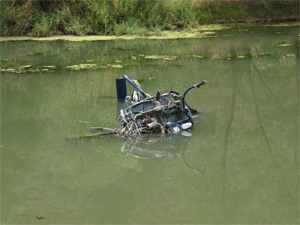
Location: Camp Verde, AZ Accident Number: WPR12FA282
Date & Time: 06/30/2012, 1207 PDT Registration: N729DP
Aircraft: AEROSPATIALE AS350B Aircraft Damage: Substantial
Defining Event: Low altitude operation/event Injuries: 4 Fatal
Flight Conducted Under: Part 91: General Aviation - Personal
The helicopter impacted an unmarked cable system in a deep river canyon. A photo of the cableway taken by the U.S Geological Survey (USGS) before the accident showed that the cable suspended over the river was not visible against the terrain background; and the cableway did not meet FAA aerial marker requirement criteria. Following this accident, the USGS replaced the cableway with aerial markers. The accident occurred within a designated Special Conservation Area, which the FAA recommends avoiding, if practical. If flown through, pilots should make every effort to fly at least 2,000 feet above ground level.
The pilot's post-accident diphenhydramine (Benadryl) level suggests that he had taken it within an hour of taking off. Diphenhydramine, an antihistamine, causes marked sedation, is a central nervous system depressant, and it can alter mood and impair cognitive and psychomotor performance.
Probable Cause and Findings
The NTSB determined the probable cause of this accident to be the pilot's improper decision to fly at a low altitude through a river canyon, contrary to voluntary guidance within the Special Conservation Area, which led to collision with a cable. Contributing to the pilot's decision were his cognitive and psychomotor impairment from his use of an antihistamine medication.
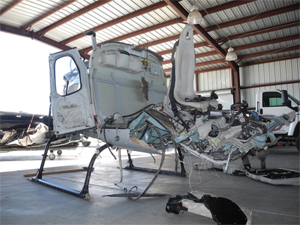
Location: Superior, AZ Accident Number: WPR16FA040
Date & Time: 12/15/2015, 1723 MST Registration: N74317
Aircraft: AIRBUS Helicopters AS350 Aircraft Damage: Substantial
Defining Event: Low altitude operation/event Injuries: 2 fatal, 1 serious
Flight Conducted Under: Part 135: Air Taxi & Commuter - Non -scheduled - Air Medical (Discretionary)
The pilot was repositioning the helicopter to its base following an air ambulance flight. The paramedic, who survived the accident, reported that after refueling, he departed and headed east towards mountainous terrain. During the final few minutes of the flight, the helicopter's altitude above the ground varied between 30 feet and 770 feet.
About 30 seconds before impact, the helicopter flew east over a north-south canyon and continued through a saddle on the canyon's east wall, clearing the terrain by about 30 feet. As the helicopter passed over the eastern ridgeline, it banked to the right and reached a ground speed of about 120 knots. After the helicopter cleared the ridge, it started to descend and accelerate. The ground speed reached a maximum of 148 knots, and about 10 seconds later, there was an abrupt increase in the helicopter's pitch and right roll rates, consistent with right and aft cyclic inputs. The helicopter impacted terrain on the northwest facing slope of a ridgeline, near a saddle, at an elevation of about 5,035 feet.
Probable Cause and Findings
The NTSB determined the probable cause of this accident to be the pilot's loss of helicopter control in mountainous terrain as the result of operating the helicopter outside the performance envelope of its hydraulic system and encountering the servo transparency phenomenon. Contributing to the accident was the pilot's decision to perform low-level, high-speed maneuvers through mountainous terrain.
Location: Bonham, TX AZ Accident Number: CEN14CA142
Date & Time: 02/14/2014, 1513 CST Registration: N494SH
Aircraft: Robinson Helicopter Company, R44 II Aircraft Damage: Substantial
Defining Event: Low altitude operation/event Injuries: 3 none
Flight Conducted Under: Part 91: General Aviation - Aerial Observation
The pilot flew locally about 40 minutes on an aerial observation flight. He reported that the helicopter was positioned upwind when he began flying crosswind over a tree line and it descended between 10 to 15 feet above the ground. The pilot stopped the helicopter's descent and forward speed to make a left pedal turn. While in a stabilized and "stationary" downwind hover for about two to three seconds, the helicopter suddenly pitched forward without cyclic input and it started to move forward and descend. For about one to two seconds the helicopter continued to accelerate forward while losing more altitude. The pilot was unable to stop the helicopter's forward movement with neither full aft cyclic nor the descent by adding power to the engine's red line. He decided to make a right turn into the wind with right pedal and cyclic where further altitude was lost. The front of the right skid came in contact with the ground and the helicopter settled onto its right side after the main rotor struck the ground.
Probable Cause and Findings
The NTSB determined the probable cause of this accident to be the pilot's inadequate recovery from a loss of tail rotor effectiveness during a low altitude downwind hover in a gusty wind condition resulting in the helicopter contacting the ground and rolling over.
CEN18LA183
14 CFR Part 91: General Aviation
Accident occurred Saturday, May 19, 2018 in Stoneburg, TX
Probable Cause Approval Date: 04/30/2019
Aircraft: HUGHES 369A, registration: N369GK
Injuries: 4 Serious
NTSB investigators may not have traveled in support of this investigation and used data provided by various sources to prepare this aircraft accident report.
The commercial pilot was conducting an aerial tour flight to hunt hogs in the helicopter with four passengers on board. As the pilot was returning to the landing zone and the helicopter was about 125 feet above the ground, a passenger saw a coyote below the helicopter and reported it to the other occupants. The pilot then chose to chase the coyote and suddenly made a tight, right turn and then entered a steep descent, which resulted in the helicopter rapidly approaching a tree line; the pilot initiated a climb, but the helicopter impacted the trees and then terrain.
Post-accident examination of the helicopter revealed no evidence of any pre-impact mechanical malfunctions or failures that would have precluded normal operation. The pilot was operating the helicopter unsafely at a low altitude, which likely resulted in him seeing the tree line ahead too late to avoid impact with the trees.
The NTSB determined the probable cause of this accident as the pilot's unsafe and aggressive operation of the helicopter at low altitude, which resulted in impact with trees.
Technical Related Lessons
Reckless, abrupt maneuvers should be avoided, especially when operating in close proximity to the ground. Low altitude, high-speed flight requires vigilance to avoid ground collision. (Threat Category: Abrupt Maneuver, Low Altitude Operations, Ground Collision)
- Low altitude flight reduces available reaction time and increases chances of obstacle/terrain collision. Aircraft flying at relatively high speeds at low altitudes have very little margin to recover from anything that might upset the flight path, turbulence, inadvertent control inputs or unexpected obstacles. In addition, altitude buys time to assess and address other issues that can present themselves, on any flight. The pilot needs to evaluate the risk of any maneuver versus the operational value. In this accident, the pilot intentionally descended to and flew at a low altitude.
Mental and physical impairments can lead to careless or reckless operation of an aircraft and endanger the life or property of another. (Threat Category: Medical)
- Decision-making, vision, reaction time, and coordination are negatively affected by physical and mental impairment. The pilot, through use of prohibited medications, put the aircraft and passengers at unacceptable risk.
Common Theme Related Lessons
The regulations for medical certification initial issuance and renewals rely upon the pilot's honesty and integrity and, if applicable, an operator's oversight to ensure pilot medical fitness before each flight. Compliance depends on the applicant's truthful and immediate disclosure of any known disqualifying medical condition as well as a required FAA oversight Safety Management System (SMS) that includes the company's robust monitoring of their pilots. (Common Theme: Organizational Lapses).
- This accident underscores the important integration of regulatory requirements, the pilot, and the certificated operator to ensure each pilot's medical fitness. Safety is achieved by a two-fold approach that includes the honesty of the pilot as well as regulatory processes that ensure a pilot's medical fitness through effective oversight by the FAA and operators.
